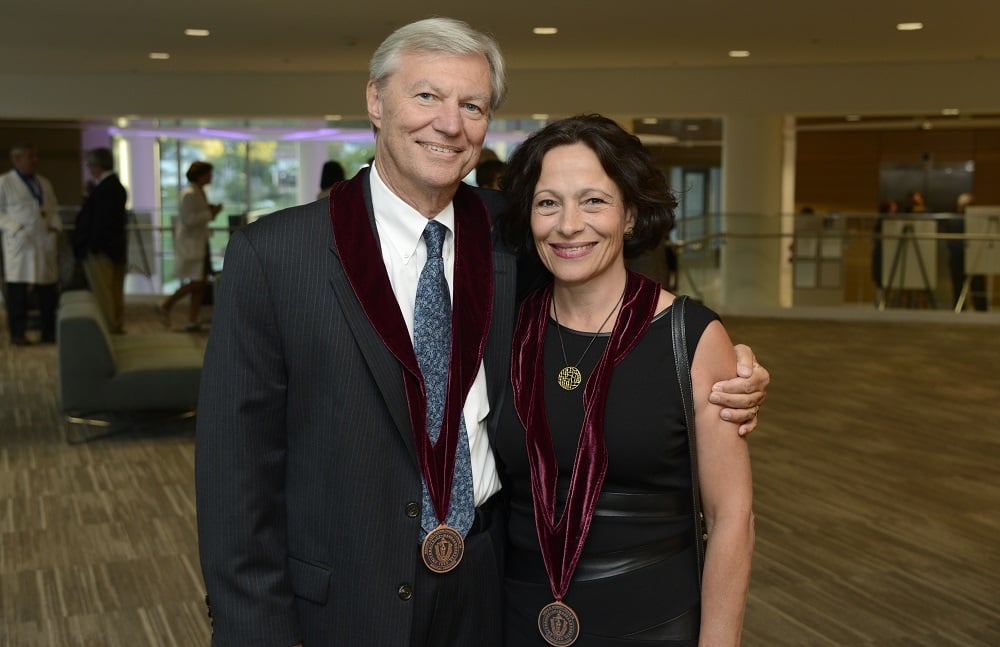Current Research Projects
Our lab offers a variety of Graduate Student Rotation Projects exemplified by the following abstracts and the lab colleagues involved in the studies:
An Ex Vivo Therapeutic Approach for Type 2 Diabetes with Genome-Engineered Adipocytes by CRISPR/Cas9
Emmanouela Tsagkaraki, Sarah Nicoloro, Yuefei Shen and Mark Kelly
Molecular Medicine, UMass Chan Medical School, Worcester, MA
Type 2 diabetes, a disruption of glucose homeostasis, is a major global health problem in search of therapeutics that can fully prevent or cure the disease. One approach is to exploit distinct adipose tissue depots that are known to differentially regulate systemic glucose metabolism. White adipose tissue (WAT) is abundant in humans and is mainly lipogenic, whereas much less abundant thermogenic brown adipose tissue (BAT) is associated with a lean, insulin-sensitive phenotype possibly achieved through beneficial secreted factors. Interventions that cause “browning” of WAT to produce “beige” adipocytes appear to be beneficial, and heterologous transplantation of BAT or beige cells in mice significantly improves glucose homeostasis. We aim to convert abundant white adipocytes into beige cells by CRISPR genome-editing with gRNA-Cas9 ribonucleoprotein complexes (RNP). CRISPR-based methods in our lab avoid uncontrolled integration of foreign DNA segments into the adipocyte genome, adverse immune responses and off-target effects that may disrupt favorable metabolic actions of therapeutic, gene modified brown or beige adipocytes.
We previously achieved genome-editing via CRISPR delivery Particles (CriPs), achieving index percentage up to 43.8% (Shen et al, JBC, 2008) in the Nrip1 gene identified as a suppressor of adipocyte “browning” (Powelka et al, JCI, 2006). In our present studies we developed a new method to deliver RNPs to pre-adipocytes and achieved frameshift indel percentages for Nrip1 up to 97%. With this optimized technology, a marked increase in adipocyte browning is achieved, while residual Cas9 protein and sgRNA are rapidly degraded. In collaboration with the Silvia Corvera laboratory, implantation of the CRISPR-enhanced human brown-like adipocytes into high fat diet fed mice decreased adiposity and liver triglycerides while enhancing glucose tolerance compared to mice implanted with unmodified adipocytes. These findings advance a therapeutic strategy to improve metabolic homeostasis through CRISPR-based genetic modification of human adipocytes without exposure to immunogenic Cas9 or delivery vectors. View our data in Nature Communications.
An RNAi Therapeutics Strategy for Nonalcoholic Steatohepatitis (NASH) in Type 2 Diabetes
Batuhan Yenilmez, Kyounghee Min and Mark Kelly in collaboration with the Anastasia Khvorova laboratory
Nonalcoholic steatohepatitis (NASH) is a severe liver disorder characterized by triglyceride accumulation, severe inflammation, and fibrosis. With the recent increase in prevalence, NASH is now the leading cause of liver transplantation, with no approved therapeutics available. Despite years of research, the exact molecular mechanism of NASH progression is not well understood, but fat accumulation is believed to be the primary driver of the disease. Therefore, diacylglycerol O-acyltransferase 2 (DGAT2), a key enzyme in triglyceride synthesis, has been explored as a NASH target. RNAi-based therapeutics is revolutionizing the treatment of liver diseases, with recent chemical advances supporting long term gene silencing with single subcutaneous administration. Here we identified a hyper-functional, fully chemically stabilized GalNAc conjugated siRNA targeting DGAT2 (Dgat2-1473) that upon injection elicits up to three months of DGAT2 silencing (>80-90%, p<0.0001) in wild-type and NSG-PiZ “humanized” mice. Using an obesity-driven mouse model of NASH (ob/ob-GAN), Dgat2-1473 administration prevents and reverses triglyceride accumulation (> 50%, p:0.0008), resulting in significant improvement of the fatty liver phenotype. However, surprisingly, the reduction in liver fat didn’t translate into a similar impact on inflammation and fibrosis. Thus, while Dgat2-1473 is a practical, long-lasting silencing agent for potential therapeutic attenuation of liver steatosis, combinatorial targeting of a second pathway may be necessary for therapeutic efficacy against NASH. Our laboratory is currently exploring additional targets that may synergize with DGAT2 silencing to alleviate NASH. View our data in Molecular Therapy
Molecular Mechanisms of Adipose Energy Expenditure and Insulin Resistance
Leslie Rowland, Adilson Guilherme and Kaltinaitis Santos
Program in Molecular Medicine, UMass Chan Medical School
Adipose tissue dysfunction leads to a variety of systemic consequences including ectopic lipid deposition and impaired glucose homeostasis and insulin sensitivity. PPARg is a master regulator of adipocyte functionality that promotes processes such as adipogenesis, lipogenesis, and thermogenesis, and thus adipocyte PPARg activity is a determinant of systemic metabolic health. Our lab recently found that adipocytes lacking the ability to synthesize fatty acids via the de novo lipogenesis pathway (fatty acid synthase knockout, FasnKO) have a significant impairment in autophagy. Interestingly, these adipocytes also exhibit a striking upregulation of expression of genes controlled by PPARg, including genes encoding proteins in the thermogenic “beiging” pathway, such as the mitochondrial uncoupling protein, Ucp1. By screening proteins in the PPARg pathway known to be regulated by autophagy, we found that a protein denoted as Nuclear receptor coactivator 4 (Ncoa4), also known to co-activate PPARg and other nuclear receptors, was not only upregulated in FasnKO adipocytes, but was indeed required for the stimulation of Ucp1 expression in primary adipocytes. Importantly, we observed that knockout of Ncoa4 in mature wild-type adipocytes blunts the transcriptional response of Ucp1 to norepinephrine stimulation but does not block lipolysis or the cAMP stimulation of protein kinase A. We also observed that Ncoa4 is upregulated in the early phase of adipogenesis and is required for adipogenesis to proceed, as knockout of Ncoa4 in preadipocytes prevents their differentiation into adipocytes to become highly insulin sensitive. These findings reveal that Ncoa4 is a novel determinant of adipocyte PPARg activity and suggest that manipulation of autophagy flux can affect PPARg activity, insulin sensitivity and adipocyte functions via Ncoa4.
This work was supported by NIDDK grants DK030898 and DK103047 from the National Institutes of Health.
Czech Lab News

 American Diabetes Association Postoctoral Fellowship awarded to Felipe Henriques. Learn more about Felipe's work.
American Diabetes Association Postoctoral Fellowship awarded to Felipe Henriques. Learn more about Felipe's work.
 Adilson Guilherme promoted to Associate Professor at UMass Chan Medical School. Congrats Adilson!
Adilson Guilherme promoted to Associate Professor at UMass Chan Medical School. Congrats Adilson!
 American Heart Association Predoctoral Fellowship awarded to Batu Yenilmez. Congrats Batu!
American Heart Association Predoctoral Fellowship awarded to Batu Yenilmez. Congrats Batu!

 Czech and Corvera Labs awarded $2.5M partnering Department of Defense grant to advance potential therapy for type 2 diabetes. Learn more
Czech and Corvera Labs awarded $2.5M partnering Department of Defense grant to advance potential therapy for type 2 diabetes. Learn more